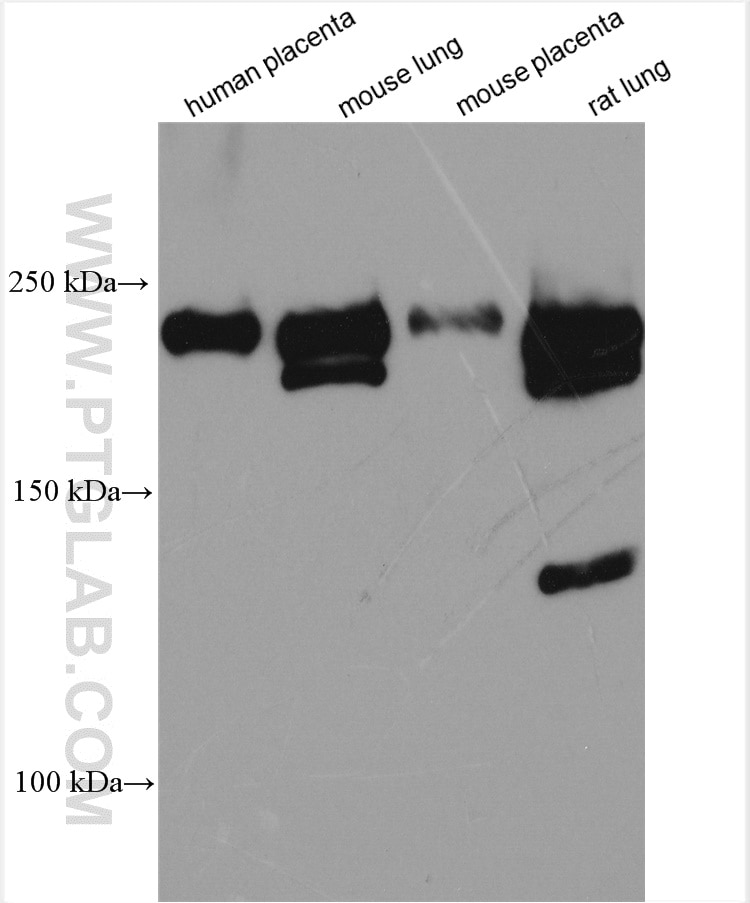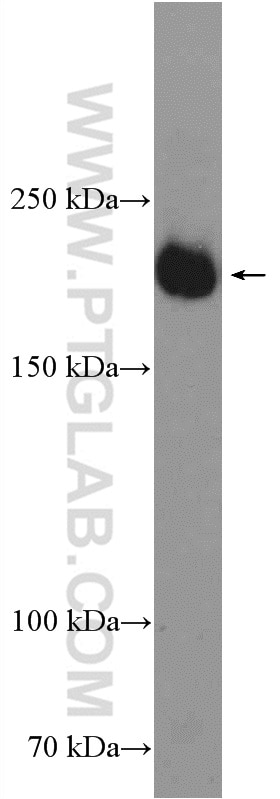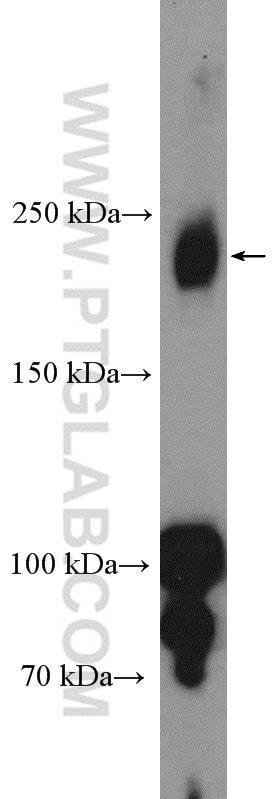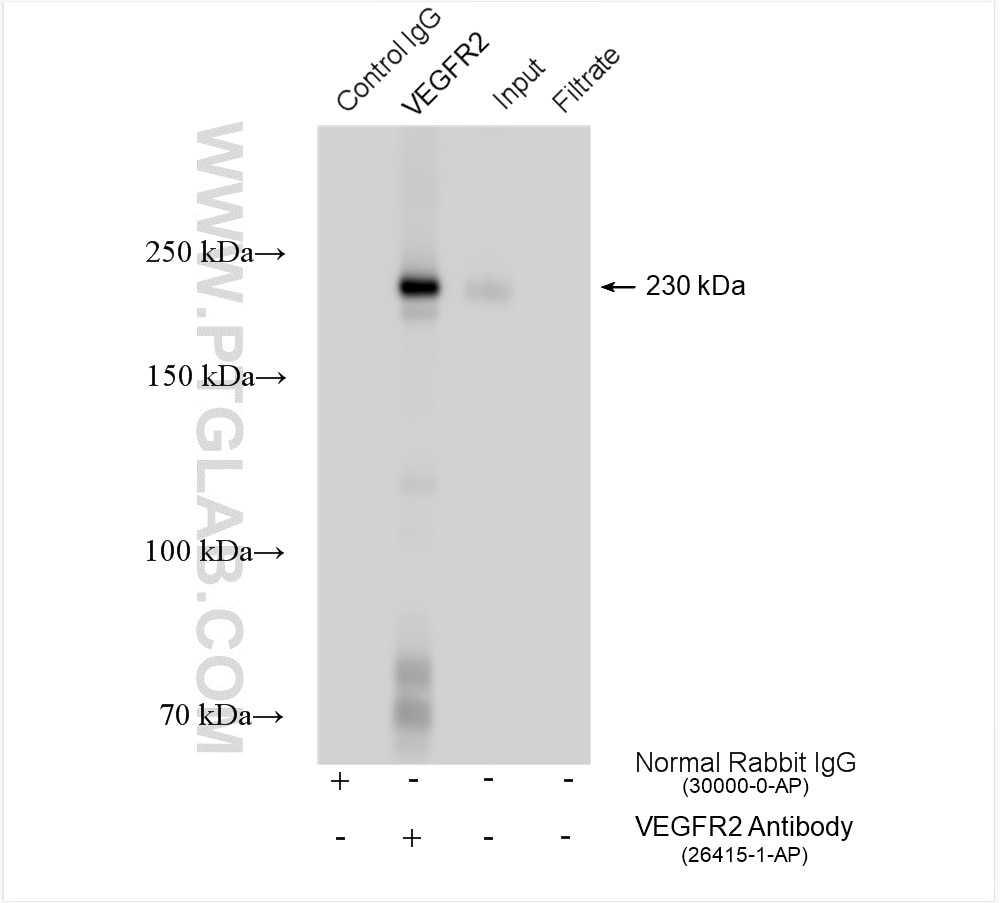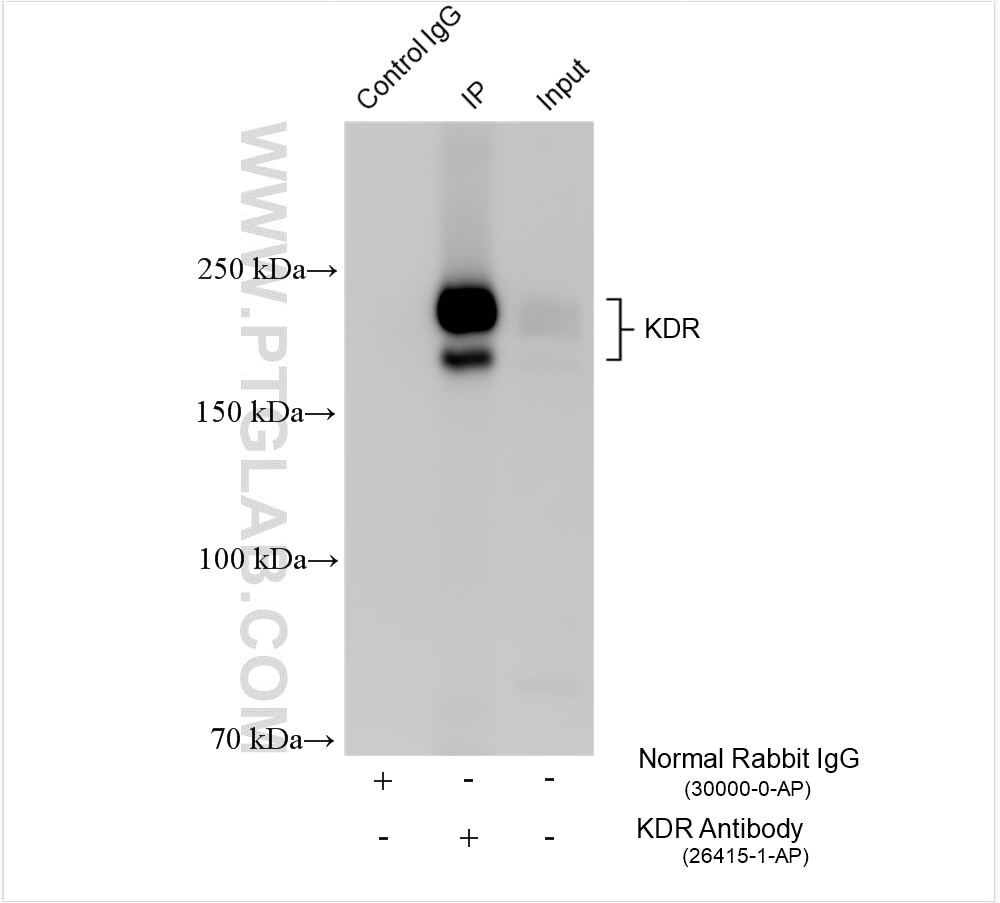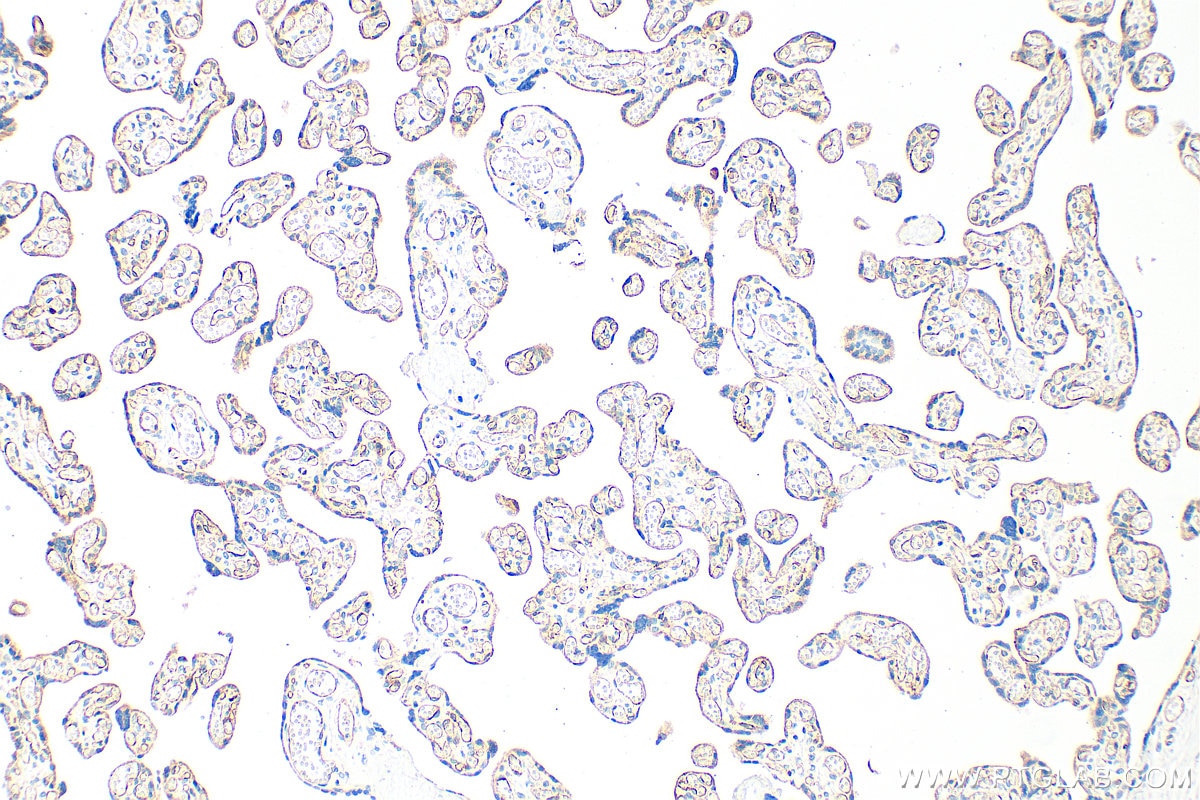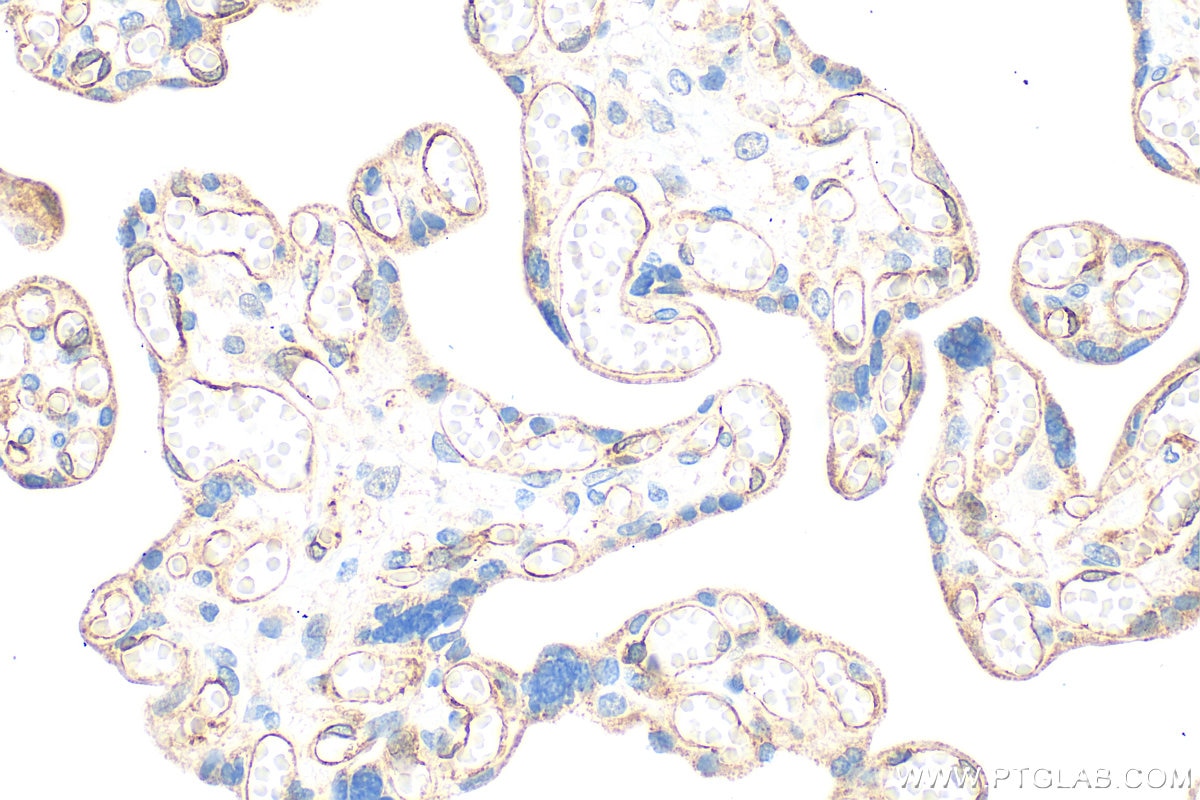- Phare
- Validé par KD/KO
Anticorps Polyclonal de lapin anti-VEGFR2/KDR
VEGFR2/KDR Polyclonal Antibody for WB, IHC, IP, ELISA
Hôte / Isotype
Lapin / IgG
Réactivité testée
Humain, rat, souris et plus (2)
Applications
WB, IHC, IF, IP, CoIP, ELISA
Conjugaison
Non conjugué
N° de cat : 26415-1-AP
Synonymes
Galerie de données de validation
Applications testées
| Résultats positifs en WB | tissu placentaire humain, tissu cardiaque de souris, tissu placentaire de souris, tissu pulmonaire de rat, tissu pulmonaire de souris |
| Résultats positifs en IP | tissu placentaire humain, tissu de muscle squelettique de rat |
| Résultats positifs en IHC | tissu placentaire humain, il est suggéré de démasquer l'antigène avec un tampon de TE buffer pH 9.0; (*) À défaut, 'le démasquage de l'antigène peut être 'effectué avec un tampon citrate pH 6,0. |
Dilution recommandée
| Application | Dilution |
|---|---|
| Western Blot (WB) | WB : 1:1000-1:8000 |
| Immunoprécipitation (IP) | IP : 0.5-4.0 ug for 1.0-3.0 mg of total protein lysate |
| Immunohistochimie (IHC) | IHC : 1:50-1:500 |
| It is recommended that this reagent should be titrated in each testing system to obtain optimal results. | |
| Sample-dependent, check data in validation data gallery | |
Informations sur le produit
26415-1-AP cible VEGFR2/KDR dans les applications de WB, IHC, IF, IP, CoIP, ELISA et montre une réactivité avec des échantillons Humain, rat, souris
| Réactivité | Humain, rat, souris |
| Réactivité citée | rat, canin, Humain, porc, souris |
| Hôte / Isotype | Lapin / IgG |
| Clonalité | Polyclonal |
| Type | Anticorps |
| Immunogène | VEGFR2/KDR Protéine recombinante Ag24589 |
| Nom complet | kinase insert domain receptor (a type III receptor tyrosine kinase) |
| Masse moléculaire calculée | 1356 aa, 152 kDa |
| Poids moléculaire observé | 150 kDa, 230 kDa |
| Numéro d’acquisition GenBank | BC131822 |
| Symbole du gène | KDR |
| Identification du gène (NCBI) | 3791 |
| Conjugaison | Non conjugué |
| Forme | Liquide |
| Méthode de purification | Purification par affinité contre l'antigène |
| Tampon de stockage | PBS with 0.02% sodium azide and 50% glycerol |
| Conditions de stockage | Stocker à -20°C. Stable pendant un an après l'expédition. L'aliquotage n'est pas nécessaire pour le stockage à -20oC Les 20ul contiennent 0,1% de BSA. |
Informations générales
KDR, also named as VEGFR-2, FLK1 and CD309, is a receptor for VEGF or VEGFC. KDR which belongs to the protein kinase superfamily, has a tyrosine-protein kinase activity. The VEGF-kinase ligand/receptor signaling system plays a key role in vascular development and regulation of vascular permeability. In case of HIV-1 infection, the interaction with extracellular viral Tat protein seems to enhance angiogenesis in Kaposi's sarcoma lesions. KDR functions as the main mediator of VEGF-induced endothelial proliferation, survival, migration, tubular morphogenesis and sprouting. Mutations of this gene are implicated in infantile capillary hemangiomas.
Protocole
| Product Specific Protocols | |
|---|---|
| WB protocol for VEGFR2/KDR antibody 26415-1-AP | Download protocol |
| IHC protocol for VEGFR2/KDR antibody 26415-1-AP | Download protocol |
| IP protocol for VEGFR2/KDR antibody 26415-1-AP | Download protocol |
| Standard Protocols | |
|---|---|
| Click here to view our Standard Protocols |
Publications
| Species | Application | Title |
|---|---|---|
Bioact Mater A bioactive composite hydrogel dressing that promotes healing of both acute and chronic diabetic skin wounds | ||
Sci Bull (Beijing) Restoring sweat gland function in mice using regenerative sweat gland cells derived from chemically reprogrammed human epidermal keratinocytes | ||
J Exp Med Secretogranin III as a disease-associated ligand for antiangiogenic therapy of diabetic retinopathy. | ||
Aging Dis MSC-Derived Exosomes can Enhance the Angiogenesis of Human Brain MECs and Show Therapeutic Potential in a Mouse Model of Parkinson's Disease. | ||
J Neuroinflammation Succinate-induced macrophage polarization and RBP4 secretion promote vascular sprouting in ocular neovascularization | ||
Bioact Mater Electrochemically derived nanographene oxide activates endothelial tip cells and promotes angiogenesis by binding endogenous lysophosphatidic acid. |
Avis
The reviews below have been submitted by verified Proteintech customers who received an incentive for providing their feedback.
FH Poulomi (Verified Customer) (07-02-2024) | The blot was good. It detected VEGFR2 in brain endothelial cells and Hek cells.
|
FH Sammy (Verified Customer) (01-20-2024) | This works well to detect VEGFR2 in HUVEC lysate. Ab diluted in 3% BSA PBST.
|
FH Kyosuke (Verified Customer) (06-12-2019) | I am working on angiogenesis study and use this for WB on HUVECs. It works very well.
|
